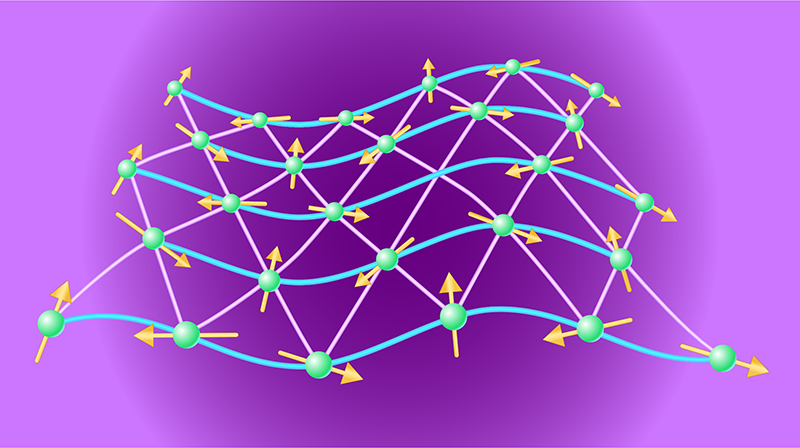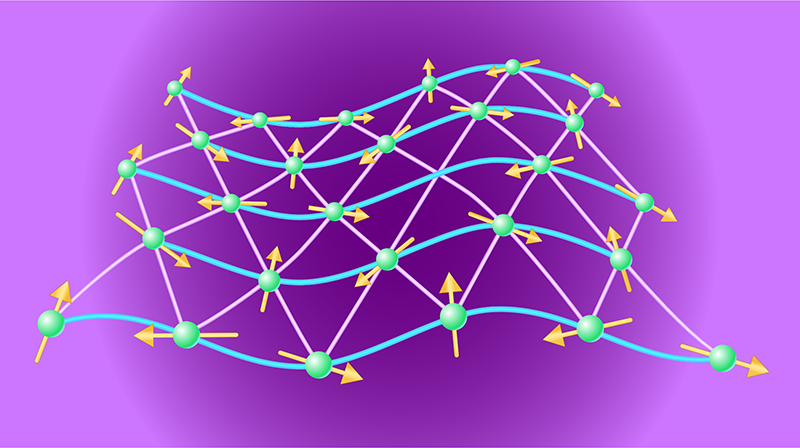Viewing a Quantum Spin Liquid through QED
The search for a quantum spin liquid (QSL) in a real magnetic material has been at the forefront of condensed-matter physics since this exotic quantum state was first proposed over half a century ago. Meanwhile, theorists continue to grapple with understanding what rich physics might emerge from this state. Now Alexander Wietek of the Max Planck Institute for the Physics of Complex Systems in Germany and his collaborators have made a significant advance toward that goal. Through numerical simulations, they have presented a compelling numerical case that the spectrum of elementary excitations of a well-studied QSL has a one-to-one correspondence with the spectrum of excitations of a well-studied quantum field theory [1]. If a real QSL is discovered or fabricated, the correspondence opens the prospect of testing theories from particle physics with condensed-matter systems. For example, it would provide us with a new “habitat” where hypothetical elementary particles, such as magnetic monopoles, could be spotted.
The word “liquid” in QSL hints at a fluid-like behavior of the magnetic moments, the spins, that constitute the basic components of the theoretical model that describes a magnetic material. In most QSL models, spins are arranged periodically in a two- or three-dimensional lattice. However, their directions do not exhibit any obvious periodic pattern and instead perform a never-ending quantum-mechanical dance for which the only classical analogy could be a flowing liquid.
It was realized early on that for spins to form a liquid, they must interact with their neighbors antiferromagnetically—that is, pairs of interacting spins should minimize their energy by being antiparallel [2]. At the same time, the lattice that the spins inhabit must be frustrated—that is, it should have a geometry that makes it impossible for the spins to settle on a single common axis in spin space to point along.
A two-dimensional triangular lattice can harbor a QSL. However, that seeming simplicity is deceptive. Consider the case in which the spins on the triangular lattice interact with their nearest neighbors only (an interaction called exchange J1). Numerous numerical and approximate analytical studies have established that this case forms the ordered “120° state” (Fig. 1). However, adding a small antiferromagnetic interaction J2 between next-nearest neighbors does the trick [3]. Such a model is known as the Heisenberg J1 − J2 triangular antiferromagnet. Several numerical studies have explored the model using different numerical methods. All of them found the ground state to be a spin liquid when 0.07 < J2/J1 < 0.15. This novel quantum state is bordered by a 120° state at small J2 and by another ordered state, a collinear-stripe state, at larger J2.
One of those studies also found that the model’s lowest-energy state can be described by a Dirac QSL [4]. This state’s rich structure is what Wietek and his collaborators explored in their new research. The theoretical description of a Dirac QSL shares striking similarities with quantum electrodynamics in two spatial directions plus time (QED3) and with two-dimensional graphene. Like graphene, the Dirac QSL hosts two sets of massless Dirac fermions corresponding to different valleys in the Brillouin zone. In addition, both sets of fermions carry an additional internal (sublattice) index and a spin quantum number. Fermions are subject to the constraint that every site of the triangular lattice is occupied by exactly one particle. In momentum space this translates into lower Dirac bands that are filled and upper ones that are empty.
A resemblance of the Dirac QSL to QED3 was previously suggested in a field theory description of the J1 − J2 Heisenberg antiferromagnet on a kagome lattice [5]. Here, the occupancy constraint was enforced by the time-like component—a scalar potential—of the emergent dynamic gauge field. The emergence of the gauge field is unavoidable because every spin operator is “fractionalized” into the product of two fermion operators. Spatial components of the gauge field originate from phase fluctuations of the exchange interaction between spins.
The QED3 structure of the Dirac QSL outlined above hints at a multitude of possible excitations, the most important of which are particle–hole excitations of Dirac fermions, photon-like waves of the gauge field, and magnetic monopoles. These excitations are characterized by quantum numbers, such as momentum and spin, and by lattice space group operations [5, 6]. Wietek and his collaborators constructed all possible QED3 excitations on a carefully chosen 36-site cluster and then evaluated their overlap with numerically exact low-energy eigenstates of the lattice spin model on the same cluster for the same set of quantum numbers. The results are encouraging. For the total of almost 200 eigenstates, they found significant overlaps, ranging from 0.4 to 0.9, in the spin-liquid region. This remarkable finding establishes an essentially one-to-one correspondence between QED3 and the J1 − J2 Heisenberg model.
A useful perspective on this result is provided by the analogy with physicist Robert Laughlin’s famous 1983 paper [7], which uncovered the physics of the fractional quantum Hall effect by demonstrating a significant and substantial overlap between the numerically computed ground state for a system of only three particles in the magnetic field and the variational wave function for the ν = 1/3 fractional quantum Hall. That overlap, which is analogous to the newly discovered QSL–QED3 correspondence, helped to open the door to fractional quasiparticles becoming candidates for topological quantum computing.
More work is needed to better understand how QED3 excitations manifest in the frustrated antiferromagnet’s physical response, which could be crucial to the experimental detection of a QSL [8]. Another important question regards the stability of the Dirac QSL to physical perturbations, such as the introduction of spin–lattice coupling and the application of an external magnetic field [9]. The progress along these and related directions requires a better understanding, both analytically and numerically, of the correlation functions of the physical operators that are constructed from the magnetic monopoles. With more work, a breakthrough may come along soon.
References
- A. Wietek et al., “Quantum electrodynamics in 2 + 1 dimensions as the organizing principle of a triangular lattice antiferromagnet,” Phys. Rev. X 14, 021010 (2024).
- P. W. Anderson, “Resonating valence bonds: A new kind of insulator?” Mater. Res. Bull. 8, 153 (1973).
- Z. Zhu and S. R. White, “Spin liquid phase of the s = 12 J1 − J2 Heisenberg model on the triangular lattice,” Phys. Rev. B 92, 041105 (2015).
- Y. Iqbal et al., “Spin liquid nature in the Heisenberg J1− J2 triangular antiferromagnet,” Phys. Rev. B 93, 144411 (2016).
- M. Hermele et al., “Properties of an algebraic spin liquid on the kagome lattice,” Phys. Rev. B 77, 224413 (2008).
- X.-Y. Song et al., “Unifying description of competing orders in two-dimensional quantum magnets,” Nat. Commun. 10, 4254 (2019).
- R. B. Laughlin, “Anomalous quantum hall effect: An incompressible quantum fluid with fractionally charged excitations,” Phys. Rev. Lett. 50, 1395 (1983).
- F. Ferrari and F. Becca, “Dynamical Structure Factor of the J1− J2 Heisenberg model on the triangular lattice: Magnons, spinons, and gauge fields,” Phys. Rev. X 9, 031026 (2019); N. E. Sherman et al., “Spectral function of the J1− J2 Heisenberg model on the triangular lattice,” Phys. Rev. B 107, 165146 (2023); M. Drescher et al., “Dynamical signatures of symmetry-broken and liquid phases in an S = 12 Heisenberg antiferromagnet on the triangular lattice,” 108, L220401 (2023).
- U. F. P. Seifert et al., “Spin-Peierls instability of the U(1) Dirac spin liquid,” arXiv:2307.12295; Y. Ran et al., “Spontaneous spin ordering of a dirac spin liquid in a magnetic field,” Phys. Rev. Lett. 102, 047205 (2009).





